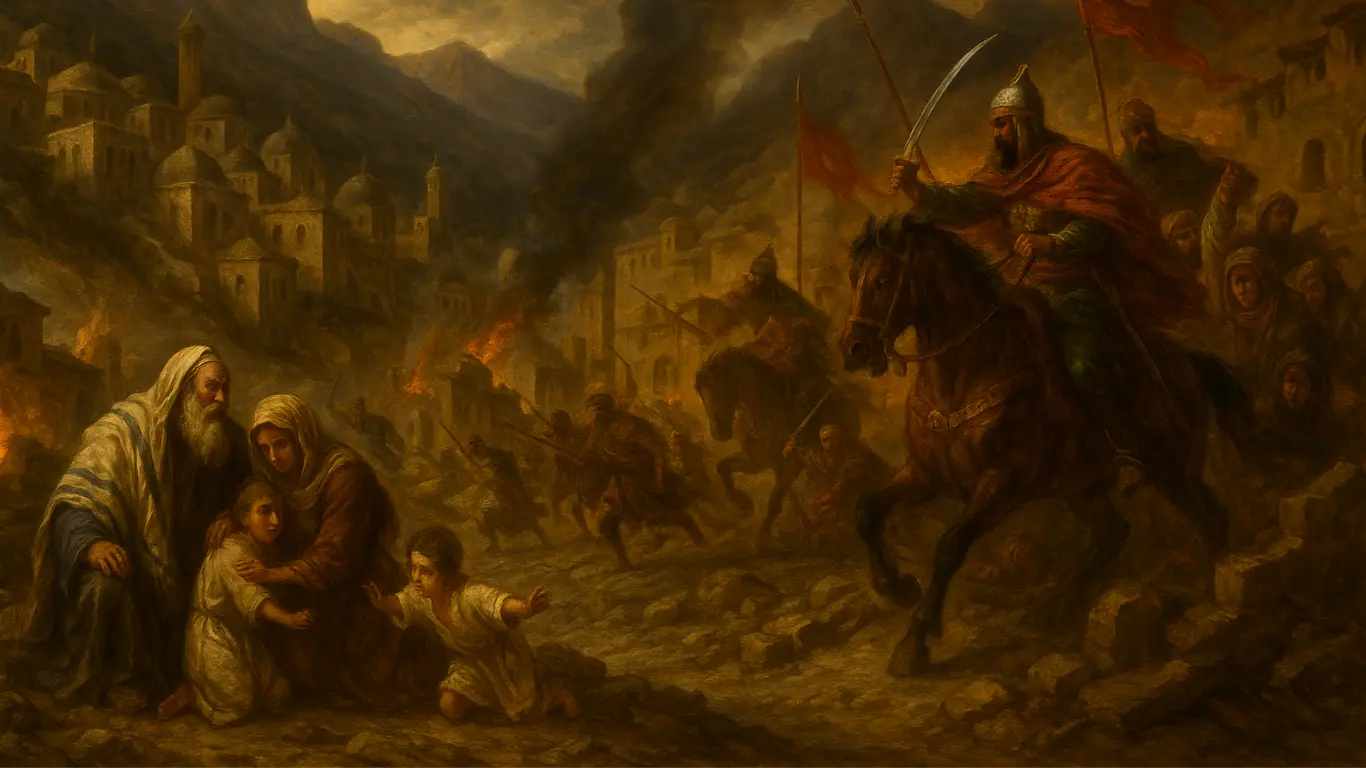The 1517 Safed attacks were violent incidents that occurred shortly after the Ottoman Empire defeated the Mamluks and took control of the Levant during the Ottoman–Mamluk War (1516–1517). At the time, Safed had a Jewish community of approximately 300 households. The attacks resulted in many Jews being killed, wounded, and forced to flee, with their homes and businesses plundered.
Table of Contents
- Background
- The Attacks
- Impact on the Jewish Community
- Ottoman Administration and Jewish Leadership
- Aftermath
Background
In 1517, as the Ottoman Empire under Sultan Selim I advanced to overthrow the Egyptian Mamluk rulers, the region experienced significant turmoil. Safed, home to approximately 300 Jewish families at the time, became a focal point of violence.
There are several competing theories regarding the exact causes of the Safed massacre of 1517. According to historians such as Ben-Ami and Mishal (Those Were The Generations, 2000: Jewish History, p. 185), the leading theory is that retreating Mamluk soldiers accused the Jewish community of supporting the Ottoman forces, fueling retaliatory attacks against them. As a result, Jews in Safed and the Galilee region were forced to flee and hide in the fields.
Aryeh Shmuelevitz highlights that the historian Rabbi Elijah Capsali, relying on Jewish informants, documented the suffering of Jewish communities during this period. Capsali noted severe acts of violence against the Jewish population of Safed and preparations for a pogrom against the Jewish community in Cairo on the eve of Sultan Selim’s conquest of the city.
The Attacks
The violence in Safed erupted in January 1517 amid the chaos following the Ottoman conquest of the region. Historical accounts differ regarding the precise instigators of the violence, presenting two main versions:
Version 1: Attack Initiated by Arab Sheikhs
According to some sources, local Arab sheikhs and influential figures, seeking to regain autonomy after the Ottoman conquest, initiated an uprising against Ottoman authority. They murdered the Ottoman-appointed governor and other officials. Amid this turmoil, the mob turned its fury toward the Jewish residents, accusing them of supporting the Ottoman invaders.
American archaeologist Neil Asher Silberman notes that the violent incident took place in Safed in January 1517. During this time, a group of local Muslims, stirred up by their previous rulers and rumors about the Ottoman defeat in Cairo, initiated a brutal uprising. This was an effort by the dispossessed local aristocracy to regain power. A mob, incited by their former leaders, killed the Ottoman governor and plundered the Jewish quarter, resulting in numerous casualties among the community members.
Version 2: Attack Initiated by Retreating Mamluk Soldiers
Other accounts, such as that provided by Louis Finkelstein in The Jews: Their History (p. 407), emphasize the role of retreating Mamluk soldiers.
Finkelstein states that although the Jewish community in Jerusalem remained unscathed by the Ottoman incursion, the Jews of Safed endured significant hardship. As the Mameluke troops retreated, they assaulted the local population, and nearby Arab villagers seized the moment to attack and plunder the Jews. In desperation, many abandoned their possessions and sought refuge in the fields.”
This interpretation is also supported by Lawrence Fine in his book Physician of the Soul, Healer of the Cosmos: Isaac Luria and his Kabbalistic Fellowship (p. 44), where he writes that Unlike the Jewish population of Jerusalem, who remained largely unscathed by the 1516 conflict between the Mamluks and the Ottoman Turks, the community in Safed faced significant hardships. The withdrawing Mamluks launched assaults on them, and nearby Arab villagers took advantage of the situation as well.
Impact on the Jewish Community
Regardless of the exact instigators, the Jewish population of Safed was severely affected. Many fled the city, and the community was temporarily displaced. According to Rabbi Joseph Garson, Jews were violently expelled from their homes, killed, and injured. They were forced to flee while their property was plundered.
Historian Abraham David notes that some survivors were forced to flee naked to nearby villages without any provisions.
Despite the destruction, the Jewish community in Safed managed to recover. With financial assistance from Egyptian Jewry, the community rebuilt homes and businesses. Within eight years, the Jewish population in Safed had grown beyond its previous size.
It is important to note that this was not the only pogrom that occurred in the region during this period. The Jewish community in Hebron also suffered attacks, with many Jews fleeing and only returning 16 years later. This event is discussed further in our article on the “1517 Hebron Attacks.”
Ottoman Administration and Jewish Leadership
Following the Ottoman conquest, the office of the Nagid, a Jewish prince-judge under the Mamluks, was abolished. The Ottomans established the position of hahambaşi (chief rabbi) in Istanbul, who represented all Jews in the empire. The hahambaşi had a Jewish officer (kahya) who had direct access to the Sultan and his government, allowing the Jewish community to raise complaints and seek protection.
Aftermath
The 1517 Safed attacks are viewed as part of the broader conflict during the Ottoman–Mamluk war. While the Jewish community suffered significant losses, it demonstrated resilience by returning and rebuilding. The attacks also highlight the precarious position of minority communities during regime changes in the Land of Israel.

